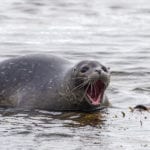“Did Al tell you that crazy story about the big muskie he caught?”
Yeah, I’ve heard that one before. But stories about fish don’t have to be hyperbolic. Telling (true!) stories about your research and life as a scientist is an effective way to engage with new audiences (and maybe meet the outreach requirements of that grant you’re applying for). Neuroscience research over the last few decades has been preoccupied with why humans respond so strongly to story. In “The Secrets of Storytelling: Our love for telling tales reveals the workings of the mind” [Scientific American paywall], Jeremy Hsu points to how storytelling appears to be a universal element of human interaction, and that many disparate cultures have stories that share common themes. Storytelling is a practice that reflects the development of culture and education, as well as the evolution of human emotion and empathy. As Cody C. Delistraty put it in The Atlantic, “[storytelling] can afford meaning to our lives.”
What are the benefits for scientists?
In my experience, an interesting or hilarious anecdote is a gateway into science for someone who wouldn’t necessarily pick up an issue of Scientific American. Over the years that I worked as a field technician, stories about falling into rivers contaminated with fecal bacteria, or diving for the flow meter we dropped in the lake were rapport-building forays into conversations about aquatic conservation, or how underappreciated species, like freshwater mussels, benefitecosystems. The future for scientists is in recognizing the potential for stories like these to serve their research goals.
The biggest perk is that people actually remember information conveyed in a story format. It’s more intuitive than a graph, and the emotional response we have as listeners (or viewers) means the message sticks with us far longer.
Storytelling can also broaden your conception of your work. Think of it as sharing an example that illustrates the ecological concept or general trend you’ve uncovered in your research. Include details that make your research tangible to a general audience, and appeal to broader themes or current events to demonstrate why your work matters.
What are the challenges?
Something that might not come easily to scientists, who are accustomed to communicating information in a polished published article, is sharing unfinished work. To develop the plots of your stories you’ll need to provide some behind-the-scenes access to your daily life, successes, failures, and works in progress. You have the opportunity to convey the challenge of executing research, from hypothesis to experiment to publication. In the process, you’ll demonstrate your enthusiasm for your work, and that might impress and surprise people who still think scientists are stodgy nerds.
How do I start?
Identify your audience
Who are you trying to reach with your story? The message, structure, and format of your story should be targeted to this audience. Think about what they already know and what they care about.
Craft your message
What are you trying to say with your story? Your message might be strictly informative (“We discovered a new species of neotropical cichlid.”), or persuasive (“Many species of neotropical cichlid are threatened by development before we even discover them. We need to protect their habitats.”). Your tone might be playful, serious or controversial.
Be realistic about the words and concepts that your audience will recognize, and speak in their language. Eliminate or explain scientific jargon.
Choose a structure…
How will you reach the audience with your story? The structure and medium are the vehicles that deliver your message to your audience.
According to Jerod Foster, author of Storytellers, there are five C’s to a story: context, conflict, climax, change, and circularity. In brief, the storyteller sets the context and introduces intriguing characters. The conflict challenges the characters and creates meaning in the story, because something important is at stake. In the climax, battles are won or lost, and emotions are stimulated. The ending provides resolution of the conflict and emphasizes the story’s message. Circularity refers to repetition in the plot, or how the ending of a story can bring us back to the beginning.
There are existing formats that can help you develop your story. You may have heard of Randy Olsen’s “And, But, Therefore” approach. Pixar reportedly built narratives using this series of fill-in-the-blanks:
Once upon a time ________________________.
Every day, ________________________.
But, one day ________________________.
Because of that, ________________________.
Because of that, ________________________.
Because of that, ________________________.
Until finally, ________________________.
And ever since then________________________.
Characters can really draw people into your story. Include people who are eccentric, charismatic, or engaging. I chose to start this video, on the history of the Ichthyology collection at the Royal Ontario Museum, with a reflection by Dr. W.B. Scott, because his voice, appearance, and experience are so powerful.
…and a medium
There are many different forms that your story might take: podcasts, infographics, poems, etc. You don’t have to learn a whole new set of skills. Repurpose your existing research tools, like GIS, video editing, or data visualization to create accessible stories for your audience. You can also get ideas by reading, listening to, and watching the content shared online (search for #scicomm) and in other blog posts in this series. Here are a few of my favourite examples:
- Narrative: Use illustrative, metaphoric language to describe nature, scientific inquiry, and cultural practices, like in this piece by Ann Finkbeiner in Hakai Magazine. Long-form narrative, targeted to venues beyond peer-reviewed journals, offers a chance to ratchet up the word count, employ emotion in describing your research, and inform a broad audience of curious readers.
- Photography: Storytelling with photographs is not just about producing a technically perfect image, but about capturing a meaningful moment. A collection of photos will work together by leveraging different visual scales and angles, characters, setting and moments, so that the audience gets a sense of what is unfolding. The PROOF blog shares the stories behind National Geographic photography, including this article about Dr. Enric Sala, a marine biologist turned Explorer-in-Residence.
- Multimedia: A fantastic example of science communication via videography is Emily Graslie’s The Brain Scoop, a wildly successful blog and YouTube channel that eventually earned her the position of Chief Curiosity Correspondent at The Field Museum in Chicago. It’s effective not only because it gives viewers insight into how museums conserve artifacts but also because Graslie’s enthusiasm for dead things is contagious. Another example is Over Water Under Fire, a nonlinear multimedia timeline of energy production and the Colorado River, produced by students from the University of North Carolina’s School of Media and Journalism.
Share and iterate
Using one of the structures described above is a great way of getting started, because it helps you identify the elements of your research that serve the story. With practice, you’ll develop your own process. When you share your work online, notice how audiences respond to different characters, stories, and media. Do videos get more likes than long-form narratives? This information can help you improve your next story.
Over time, you will build an audience of followers who are interested in both your science and the way that you communicate. Some will want to collaborate. As you develop a portfolio of stories, overarching narratives and themes will emerge, which may even help you identify creative new directions for your research.




